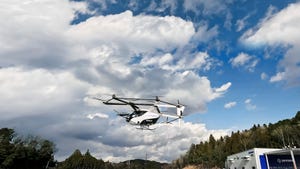AI-Powered Robotic Weeder Developed at University of IdahoAI-Powered Robotic Weeder Developed at University of Idaho
The three-foot-wide, wheeled robot uses AI to scan, identify and pinpoint weeds up to half an inch wide
_(1).jpg?width=1280&auto=webp&quality=95&format=jpg&disable=upscale)
A team of computer science researchers from the University of Idaho Coeur d’Alene successfully demonstrated an autonomous robot that can be used to eradicate weeds using artificial intelligence (AI).
The three-foot-wide, wheeled robot uses AI to scan, identify and pinpoint weeds up to half an inch wide. The robot then zaps the weed with electricity, eradicating it.
Following the demonstration at the U.S. Forest Service’s Coeur d’Alene tree seedling nursery, the team behind the robot intends to develop a weatherized case for its hardware, improve its electrical components and increase the AI’s accuracy in identifying weeds. Data collection and testing are set to continue through next year.
The robot was designed in partnership with the U.S. Department of Agriculture (USDA) as it seeks to improve reforestation efforts within the national forest system, which is overseen by the Forest Service. The university announced in January that it received a $139,000 USDA award to develop the system as part of an effort called Project Evergreen.
“It’s all about sustainability,” said Kas Dumroese, a former senior research scientist with the Forest Service who led the initial project development. “The robotic device U of I is developing underscores the Forest Service’s commitment to conservation leadership and biological diversity. Autonomous weed eradication will reduce our labor costs and reliance on chemical pesticides and fossil fuels, improving locally adapted plants and strengthening reforestation efforts.”
The Coeur d’Alene nursery is one of six such facilities operated by the Forest Service nationwide. The service spends $500,000 per year controlling weed growth at the nurseries, with most weeding performed by hand. Weed reduction improves seedlings’ access to soil nutrients, resulting in stronger seedlings, reduced nursery costs and improved reforestation, backers said.
The Forest Service was tasked with increasing reforestation efforts under the Repairing Existing Public Land by Adding Necessary Trees (REPLANT) Act. Included in the 2021 Infrastructure Investment and Jobs Act, REPLANT aims to reforest 4 million acres of U.S. forests by planting more than 1.2 billion trees over the next decade.
“This effort is a win-win for the Forest Service and the university,” Dumroese said when the initial grant was announced in January. “The university, with its expertise and facilities to develop these types of machines, can also train and develop students proficient in intelligent robotics. For the Forest Service, this collaboration can help the agency meet provisions of the REPLANT Act, meet goals to sustain our nation’s forest and deliver benefits to the public.”
Read more about:
Smart FarmingAbout the Author
You May Also Like







